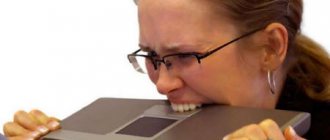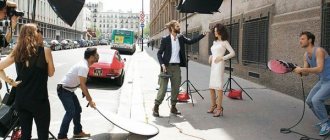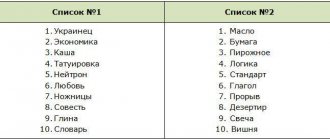Fantasy and imagination are integral parts of our lives. Creativity and creative professions are impossible for a person without imagination, which goes with us throughout our entire life, from birth to old age. A good imagination helps in everyday life, making it rich and fulfilling.
Salvador Dali. Scream.
But what to do when your imagination is not very developed, and in order to come up with something you have to make an effort? Our tips and simple exercises will help!
Developing speech
Naturally, any person’s speech begins to develop from an early age, when children become familiar with their surroundings. However, it is still possible to help them. The main thing is to do it correctly so as not to harm the child.
There are three generally accepted ways of developing speech: visual, practical and verbal. In preschool organizations, a visual method is most often used, which consists in the teacher himself telling children about the world around them.
So, there is a direct version of this method, which involves visiting excursions or simply pointing at one or another object and pronouncing its name. Another option is indirect, which develops speech by describing certain images or toys. Thus, the skills of coherent speech are improved, and the vocabulary of children is consolidated.
Image+action
A little more difficult than the previous one, but usually after a couple of days of training everyone starts to find it easy.
We take one object and take an action from another. As a result, we get the desired absurdity that develops the imagination.
Examples. Nightstand + notebook. We take the action from the notebook. It opens, you can write in it, etc. We get it - the nightstand writes in a notebook. You can further develop what he writes, why he writes, to whom he writes... But for starters, that’s enough. Because, in this case, our task is not to make a cute guy, but simply to pump up the imagination.
Lamp+robe. In principle - it’s not bad at all - a lamp in a robe. Bann. Apparently he had just come from the bathhouse. This means she is also wearing a turban. But if you strictly follow the letter of the technique, then the robe that catches your eye is fluffy. So, another option is to cover the lamp with fur. Or rest in peace. Or - laughter. Fur lamp. Hairy. Laughing.
In this case, as I already said, we are not chasing the beauty of the image and are not trying to ensure that the images are funny or extreme. We just mix everything together.
Ways to develop speech
The verbal method of speech development is more common in schools. It involves oral retelling of stories or memorizing texts. By pronouncing a text, a person improves not only memory, but also diction, which helps improve speech skills. The verbal method also includes describing various toys or paintings without visual contact with the object being described. That is, a person must talk as colorfully as possible about a picture or toy he saw earlier.
A practical way is through intellectual games, in which there is an element of speech development. For example, these could be all kinds of quizzes, dramatizations or educational games.
Kinds
Active imagination enhances the motivation of activity and a person transforms reality - he invents, embodies an artistic concept, and brings closer the future he dreams about.
- Active reconstruction builds an image according to the description.
- Active creativity builds an image of something that has not yet existed.
All culture is created by creative imagination.
Passive imagination undermines the motivation of real behavior; images reproduce themselves. Dreams and projections multiply and do not become reality. A time-out is necessary, but the pause can drag on, and life will pass as if in a dream.
- Passive intentionality is controlled by a person who himself evokes memories, dreams, and fantasies.
- Passive unintentional controls a person when he accepts delusional, dreamlike images as reality.
Techniques
In addition, several methodological techniques can be distinguished. For example, verbal ones, which, in turn, have subtypes:
- Speech samples. When the teacher himself builds a speech that is accessible in form and content. For older children, a correction method is used when the teacher begins to correct the phrase said by the child.
- Repetition. In this case, words or phrases are deliberately repeated several times for memorization purposes. The main thing is to choose a form of learning that is convenient for the child. For example, choral or joint speaking.
- Explanation. This method is used in cases of explaining to a child the concept of a particular object. Also, explanation implies disclosure of the need and properties.
There are also visual techniques that teach correct sound pronunciation and articulation. And gaming ones that attract children into educational games.
Draw with dots
A blank sheet is a window to another dimension. You dip your brush into the ink and place a dot in the very center of the sheet. And immediately the creation of the universe begins, and with it the countdown of time, matter, life, light. Everything arises with a dot, a relationship between black and white begins: a black dot on a white sheet is already a drawing.
“The black dot is a clear sign. But if next to this point I put a second, then a third, then confusion arises,” says Henri Matisse
If you are going to become an artist, no matter how funny it sounds, you must first put an end to it! Let's start with something simple. Place black dots with a pen or brush on the clean surface of a sheet of paper. Looking at a dot, we can experience emotional excitement, imagining the loneliness of this dot on a white sheet of paper.
Then we begin to fantasize: move this point or increase the number of points, thereby creating even more rich life and drama in the picture. They can dance, they gather into constellations. And here in front of us is the starry sky.
Try creating a drawing that consists only of dots. - Source
“One day, while listening to the songs of a Georgian choir, I decided to draw a line of sound, a line of singing. So intricately, shimmering, the voices of Georgians sounded endlessly, sitting somewhere on long benches under the blue mountains.
I thought about the old Warsaw master, took his brush, dipped it in mascara and began! In ten hours, under a hundred Georgian songs, I painted almost a hundred sheets of paper, folded them together, wrapped them in a cover and called it the book “Caucasus”. And everyone who saw her clearly heard the quiet songs that I listened to when I drew these lines.”
DETAILS: Marina Alexandrova's ex-husband regrets his betrayal
A cartoonist is a clown who draws. Leonid Tishkov has this picture: after a performance, a tired clown sits in the dressing room. He took off his cap and shoes, and it turned out that his head was as long, elongated and cone-shaped as the cap itself, and his legs were as huge as clown shoes. Only he hasn’t taken off his round red nose yet, so we don’t know what kind of nose he really has.
- Anna Karenina, move away from the edge of the platform!
Draw a caricature on some topic that worries you.
Source
Take an old roll of wallpaper, roll it out in a room or hallway and paint with a large brush, sparing no paint. Give vent to your emotions. Involve children in this activity. And then fold it up like an accordion and call it a family art album.
How to develop imagination?
Developing a child’s imagination and imagination is very important. But these abilities also need to be formed or consolidated in adulthood. From early childhood, a person must accumulate a visual representation of objects. When developing this ability, it is important to look at as many illustrations and objects as possible, focusing on the smallest details. Having carefully memorized an element, you need to mentally imagine it, remembering all the nuances from memory.
Also, developing imagination requires effort. For example, a person engaged in creativity often cannot finish his work, because he simply sits and waits for his imagination to work in the right direction. This way you will not be able to achieve the desired result.
Experts in this field recommend making your imagination work through effort. For example, a person who paints landscapes is advised to visit picturesque places more often, and people who study music are advised to draw their imagination from other compositions.
Only the ability of mental concentration can provoke the development of imagination, which subsequently begins to act in the right direction.
Thus, there are two main directions in the development of imagination:
- recreating, when a person restores in memory the previously seen images of heroes of books, stories and other literature;
- creative, when a person independently comes up with the appearance of the heroes of stories, novels and other things.
Processes and mechanisms
In perception, a person takes information from the external world, such as light or sound waves, and makes meaning of it using memory and perceptual processes.
In the imagination it works the other way around . Imagery is created from memory.
What is not obvious is that this important, fascinating phenomenon can be studied scientifically. Even though we can't read images directly from people's brains (yet), there are still scientific means to figure out what's going on in someone's head.
Things belonging to an extended nature are first perceived by the senses of the body, where their ideas are combined with new impressions and then fantasies appear .
Man cannot grasp the infinity of nature with his gaze; the gaze focuses on some fragment of it, for example, on the glass in the window frame of a bus.
Flashing images in front of the eyes would be completely inappropriate if they did not project rays of light onto words, cut them into pieces and capture the constantly changing image, and then associate it with sounds or specific words.
Mechanisms of imagination:
- agglutination - the creation of a new image from parts of other images;
- metaphor is the transfer of a name from one thing to another, from a genus to a species, from one thing to another according to the principle of analogy. The basis for metaphor is the comparison of similarities between objects and words;
- hyperbolization - increasing or decreasing an object and its parts;
- fixation - concentration on special features of an object;
- typification - classification of characteristics of several objects, the use of typical and homogeneous ones.
This is perhaps most clear in dreams , where our minds churn out an entire virtual reality for us to experience while we sleep.
But imagination is used in a range of cognitive processes, including planning, hypothetical thinking, imagining things in the past or future, understanding language, and of course in design and creativity in technology and the arts.
Experiments related to the emission and absorption of light, reflection and scattering of its rays, illumination or shading of an object, and finally, good neighborliness and the mutual influence of colors, have revealed a number of previously unknown visual illusions that influence our way of understanding images appearing on the retina.
Learning about its construction and taking into account the action of the lens that turns the image, it finally became clear how much of our worldview depends on power, the play of light and shadow.
How to develop imagination?
The development of fantasy often comes with the development of imagination. Therefore, these two abilities are often improved simultaneously.
How to develop fantasy and imagination? To do this, it is recommended to read literature to the child from early childhood that helps improve these abilities. For example, children will benefit from listening to short stories at a very early age, and novels and science fiction literature as adults.
The main thing when teaching a child is to explain to him that this ability is extremely necessary. After all, it is from this that the possibility of imagination arises.
read books
There's such a moon in the sky,
The fresh cut turns white.
We can also perceive not only the moon, but also an apple, a mug, a plaster nose. The first thing a creative person must learn is to look. On things. To the world around him. Look around, choose an object and write a haiku about it - a short tercet.
Illustration from the book
Think about what kind of monument you would like to erect? And in what place? Leonid Tishkov mentions in the book a monument that was erected on Pushkinskaya Embankment in Gorky Park in 2020. “Lighthouse Diver” - an unusual art object is the world’s first lighthouse, which is a statue of a diver.
Source
What kind of monument would you like to create? Think over the concept of your art object, what will be its meaning, where will it be installed? Draw a sketch.
Everyone has a favorite book - fiction or non-fiction. Feel like an illustrator - draw your own version of the cover.
“When illustrating Beckett, Ionesco, Zamyatin, Ilf and Petrov, each time I came up with my own myth, adjacent to the writer’s plot, like a parallel dimension. Naturally, one fine day my worlds gained independence and, like rainbow bubbles, flew over the earth and took on a life of their own.”
Leonid Tishkov
Spread of the book "The Hunting of the Snark". Illustration from the book
Useful articles
Cooperative learning
How to develop creative imagination? Another good method is to come up with ideas together. For example, parents should provoke the child to create a mental image of an unrealistic situation. So, experts advise adults, for example, to find out from their baby what he would do if he had wings, what magical land the child wanted to go to, how he imagines a castle of knights or princesses. The development of fantasy consists in the child’s fascination with one or another thought and its further development.
How to develop imagination? You can ask your child to come up with a short story. Or let it be a whole fairy tale about a situation seen on the street. For example, ask your child to tell you where the cat you met on the road ran to, what she was doing or will do, whether she has kittens, and so on. Here are some tips on how to develop your imagination. Such exercises will be effective if you do them regularly.
The main thing is to act
From experience I can say that many people experience difficulties with imagination at first. And it is with simple techniques that you can achieve results the fastest.
It is interesting that the person himself usually does not really notice that he changes as his figurative space opens and develops. But from the outside it is very interesting to watch.
After all, what awakens in a person is his creative beginning.
Many participants in the laughter training noted that when you start practicing these and similar techniques, your approach to life changes very quickly. It becomes an order of magnitude more creativity, flexibility, the ability to come up with something, as well as the ability to find ways out of any life situations and solve problems of any complexity.
With love for your fantasy, Junia
Fantasizing is not only pleasant, but also useful, so imagination can and even should be developed. But how to do this?
So, how to develop your imagination? Helpful Tips:
- Each of us watches TV, but we can do it with the benefit of our imagination. So, turn on a movie or cartoon, but turn off the sound. Watch what is happening on the screen and try to mentally voice the main characters, imagining what they might say. Come up with a plot, think about what the intonation of the characters could be.
- If you have recently seen a film or play, you can put yourself in the shoes of one of the characters and think about how you would act in a given situation. Also try to come up with a different ending or even dream up another hero.
- If you encounter difficulties, make the best of them. Even if you have found a solution, imagine how the situation could have developed differently. Come up with a few more ways to solve the problem, and not necessarily possible and real ones. For example, you can imagine that you have some unique abilities that can help you.
- Dream! Yes, yes, everyone should dream; it helps not only to develop imagination, but also to strive to realize what is planned. For example, if you dream of your own home, then imagine the place in which it will be located. It could even be the seashore or an island. Think through the interior of your home and its façade down to the smallest detail. Mentally arrange the furniture, fantasize about how you live in your new home.
- If you have a child, you can connect him too. Make up fairy tales together. Ask your child to come up with one character, and you come up with another. Think together about what the characters do and how they live. Then imagine some amazing event that will change the lives of the characters and the course of the tale. Think about how the characters will behave and how it will all end in the end.
- If you travel on public transport, then consider the people. But do it unobtrusively, otherwise your behavior will arouse suspicion. Just look at a person once, capture his image in your memory and imagine his life, his destiny. Imagine what he could do, describe all his family members, his relatives, hobbies, and so on.
- A simple technique called “Five Points” will help develop your imagination. Place five dots on the sheet in a chaotic order. Now connect them in such a way that you get some kind of pattern. Then put the five dots again and connect them in a different way. Make several drawings and add to each one to create compositions.
- Drawing various processes and phenomena will help the artist train and develop his imagination. For example, try to draw your thoughts, morning in space, night on another planet, some non-existent mythical creature. Images can be abstract, this is welcome. Be sure to add colors, and a variety of bright ones.
- You can try to come up with “fan fiction”, like fans of famous films and TV series. In general, “fan fiction” is a backstory, a different version or continuation of a story previously invented by someone. If you have a favorite movie, then think about where it all could have started, how it could have ended differently, how everything could have continued after the ending.
- Books, and certainly without pictures, will help you develop your personality in many ways and train your imagination. Read, mentally describe the characters, their facial expressions, thoughts, objects surrounding them.
- Try changing your hand sometimes. A specific hemisphere is responsible for each hand (the left is for the right, and the right is for the left). And if you use both, then two hemispheres will work at once, which, of course, will help you think creatively.
- Play a fun and interesting "What If" game. Just imagine different unusual phenomena. For example, think about what will happen if a person can fly, if people don’t sleep, if animals start talking, if the sky turns pink, if new brains start selling, and so on. And the more unexpected and sometimes even crazy your thoughts are, the more active your imagination will work.
- Creativity, any kind, will help develop imagination. You can draw, write poems or songs, develop new styles of clothing, create soap, sew or embroider, knit, and so on.
- Try to come up with unusual names for the most ordinary objects. For example, a fork could be called a “food sticker”, and a spoon a “rotator”. In general, think, associate things with some actions, and make up unusual words from these actions. It's not only fun, but also useful.
- Don’t give your friends and family banal gifts, come up with pleasant and unusual surprises. For example, if a friend is involved in business, then give him a “Treasury of Ideas”. Let it be an ordinary jar. Put notes in it with useful tips that you think could help increase your income. If mom is a salesperson, then give her a soft seat for a chair with a “sales engine”, the role of which can be played by springs. In general, fantasize and think creatively in order not only to develop your imagination, but also to please your loved ones.
- Look at the clouds and think about what each one looks like. Look at the outlines, don’t think about the real, think abstractly and use your imagination. For example, in a round cloud you can see the face or muzzle of an animal.
- You can put blots on a piece of paper and think about what they look like.
- Try fortune telling with wax, it's very exciting! Take a saucer and fill it with water. Prepare a candle, light it and drip melting wax into the water. Try to consider objects or even events in the frozen figures that form.
- Communicate more with interesting and creative people, it’s interesting and useful. Discuss their ideas, ask them to talk about their thoughts, ask for their opinions.
- Look for inspiration. Its source can be travel, new experiences, some interesting hobby, and so on.
- Look for unusual solutions to problems. For example, if something is broken, try to carry out a mini-repair using scrap materials, or even replace the item with something else.
- Practice visualization. For example, if you are striving for something, then clearly imagine that it has already happened. So, if you are developing a project, think about what its presentation will be, how you will speak, and how your ideas will be approved.
Let these tips help you learn to use your imagination and think creatively!
When visualizing
your
dreams
, when you need to very vividly imagine the moment of fulfillment of this desire, a well-developed creative mind plays an important role.
The ability to imagine your desire at the end point is an important component of the fulfillment of your desire.
This article is about how to develop your imagination
Unfortunately, not everyone succeeds. And some even believe that this is not given to them, because they tried it once and saw nothing, they are disappointed and never return to such a good assistant after achieving what they want. Meanwhile, it has been absolutely proven that absolutely everyone is endowed with imagination. Simply, for those who do not use imagination, this function of our body atrophies, but can be “brought back to life” again.
Developing your visualization
, You develop yours too. You need to understand that there is no perfect way to learn to imagine something in your imagination. After all, each person is individual, so you need to choose the method that is more suitable for you and your feelings. Try the simple methods described below. It is quite possible that they will be suitable for you.
Exercises to develop imagination:
1. Relax, close your eyes, and imagine the number 1 in red, gradually it changes to the number 2 in orange, after which the number 3 in yellow appears. The number 4 will be green, and the number 5 will be blue, followed by the number 6, which will be blue, and the last number 7 will be purple.
This arrangement of colors in numbers corresponds to the order of colors in the chakras. To make it easy to remember these colors, use a hint familiar to everyone from childhood: Every Hunter Wants to Know Where the Pheasant Goes. This is the arrangement of colors in a rainbow.
2. Pick up some simple object. This could be a notepad, saucer, handkerchief, knitting needle, plastic bottle, mobile phone, etc. Look at it carefully and remember how it feels in your hands, that is, you need to remember exactly your feelings from touching this object. Now put it down and, closing your eyes, try to imagine it in your imagination as best you can. Open your eyes and look at those details of the object that you could not imagine the first time.
It often happens that we look at an object, but then we cannot describe it, because we perceive the object as a whole, without stopping at the little things. Close your eyes again and try to imagine the object with those nuances that you did not notice at first. I think the meaning of the exercise is clear to you. Do this exercise several times throughout the day with different objects. Allow 3-4 minutes for this between tasks.
3. Now let's complicate the task a little. The exercise not only develops imagination, but also memory. You need to take 2-3 simple objects, put them in front of you and remember the location. Closing your eyes, imagine these objects. When you are good at presenting these objects, you can take objects that have a lot of small details, colors or patterns.
4. This exercise is also more complex. You need to imagine any geometric figure: a circle, a square, a pentagon, just a line. When you manage to imagine this figure, try to spin it. Then stop and spin in the other direction. What is important here is not the creation of an object in your imagination, but the unwinding and stopping of a figure that already exists in your imagination. Try to look at this figure from all sides as it spins. If you do this without much difficulty, then paint each side a certain color and rotate the figure.
5. This is a method where you come up with exercises for yourself. Suppose you are traveling on public transport. Engage your mind with imagination
. You can imagine anything here.
You can imagine what your living room will look like if the sofa is moved to the middle of the room and the TV is raised from the bedside table to the wall. This is the room with this rearrangement that you should see. Or imagine your living room in a different color scheme.
If you are going to go somewhere, then first imagine yourself in the clothes in which you have already decided to go. And then imagine how you will look if you wear a different blouse. Once you learn how to do the first four exercises, this exercise will be easy. Moreover, the choice of clothes for going out is based on assumptions about how you will look in it, that is, the imagination is already at work.
Your boss has assigned you a creative task, but you don’t know which way to approach it? Children ask to tell a fairy tale, but nothing comes to mind other than “Kolobok”? The girl wants surprises, but you can’t understand what that means?
It's time to start looking for information on how to develop imagination in adults
. After all, it is precisely with its absence that all the difficulties that may arise in the situations described above and many other are associated.
But don’t get upset and study tons of information: from this article you will learn the most effective, yet simple techniques for developing imagination in an adult. Get ready for a journey into a fantasy world!
First, let's figure out what imagination is and why many people don't have it. So what does this word mean?
Imagination is the ability of a person to generate various images, ideas and ideas in his mind. It can be active, when you specifically imagine something, and it can be passive, that is, unconscious.
For example, if you felt hungry and your brain immediately produced a picture of a delicious burger or fried meat, your imagination came into play; if you were looking through a vacation photo and remembered how nice it was to lie on the beach, it worked.
Thus, if a person says that he has no imagination, then this is not true at all. Everyone has this ability, but it is developed in different ways. And like any other ability or skill, imagination can be developed.
This ability is most active in young children, adolescents and young men. It is during these periods of life that we learn about the world, dream, and make grandiose plans. With age, a person usually goes deeper into certain thoughts, studies, work, and pays attention only to real things and pressing problems.
And if you are not a creative person whose whole life is connected with images, but a serious programmer or sales manager, then coming up with bright ideas becomes more and more difficult every year. A person begins to think in stereotypes and sees the world too literally.
The consequence of this is boring conversations, the inability to make the world around you beautiful and colorful. How to deal with this?
In fact, developing imagination is not too difficult even for adults. The following will list various techniques and methods that will help cope with the problem of lack of active imagination.
The main condition for the success of these exercises is openness to experimentation and lack of shyness. The simplest of them are carried out only in your head, which means you shouldn’t be afraid of mistakes - no one will see them. And those methods that involve interaction with other people will help you not only develop your imagination, but also have fun.
Activating the “imaginary” with the help of visualization
Perhaps visualization is the easiest way to activate the imagination and develop it. The essence of this exercise is a detailed mental reproduction of a specific object, place, or action.
You need to start small: try to carefully look at an object lying on the table, and then close your eyes and imagine it. It could be anything, such as a book or a phone.
Developing imagination by reading books
Visualization of events from books is closely related to the previous method. Only here the task is more difficult - you need to keep many characters and images in your head, make them move and interact. Try not just to read letters and words, assimilate certain information, but to generate a complete picture.
Over time, reading books will become as exciting as watching movies... Or maybe even better! After all, when reading a book, you can not be limited by the director’s imagination, but give free rein to your own imagination, and at the same time develop it.
Let's play in associations
Associative thinking is developed in most adults. Surely, anyone can imagine the color orange when they hear the word “orange”. Playing this game with a group can not only have fun, but also improve your imagination skills.
We come up with catfish and other unknown animals
Where did the names honey badger and weevil come from? Someone invented them! Moreover, in the simplest way. Since an animal feeds on honey, then it should be called a honey badger, and that bird with a long beak should be called a weevil.
Even though the names you come up with are unlikely to be included in biology textbooks, this activity can be very fun and exciting. Combining different words and inventing new ones from them will perfectly help develop the imagination not only of children, but also of adults.
Let's get involved with art
In fact, all creative people use this method to develop certain qualities in themselves. If you lack ideas, inspiration or imagination, go to an art gallery or exhibition, watch films and master classes.
Watch others do it. Sometimes a brilliant author's concept can be born from small pieces and ideas. And if you periodically observe the work of your favorite authors, then your own ideas will not take long to appear.
Share this article with a friend:
How to develop creativity?
Every person is endowed with some set of creative abilities at birth. In some people they are naturally more developed, in others less. In the second case, when creative abilities are poorly formed, you can try to develop them using several methods. However, parents should understand that it is recommended to do this even in preschool age. After all, it is during this period that children are most liberated.
So, we develop imagination and creativity. What do we have to do? First of all, such abilities develop well during games. Even the usual construction of a tower can contribute to this. After all, children learn to improve, which means they will begin to modify the constructed structure, adding or, conversely, removing some details.
You can also develop creative abilities through modeling, drawing, singing and other activities of this kind. In addition, attending a music school is very useful. Therefore, experts recommend sending children to such institutions from early childhood.
Completion
It is quite possible to develop imagination under any conditions. For example, looking at people in transport and figuring out who they work with, who they live with, where they go, and in general, what their lives are filled with.
By the way, the alpha visualization method will help you quickly turn your dreams into reality. Even if some of them seem difficult to implement.
In addition to the fact that your imaginative thinking will improve in the process, you will also learn to make your thoughts material. With benefit, and not to the detriment of oneself, as often happens out of ignorance.
And that’s all for today, dear readers. Take care of yourself and be happy!
The material was prepared by psychologist, Gestalt therapist, Alina Zhuravina
14-01-2019
Best regards, Valery Kharlamov
Newsletter
https://qvilon.ru/Landing/podpiska.html
DID YOU LIKE THE ARTICLE? RECOMMEND TO YOUR FRIENDS!
Subscribe to site updates by leaving your email:
Subscribe
*By clicking on the “Subscribe” button, I agree to the newsletter, the processing of personal data and accept the privacy policy.
Fictional stories
Gather a group of friends and tell each other stories. A prerequisite is that fairy tales must be invented independently and preferably impromptu.
You need to feel the life of the object. If you draw a broom and dustpan, imagine that these are two fairy-tale creatures, as in the fairy tale about the Straw, the Bubble and the Lapota. A broom is not just a broom, but steppe grasses; they once grew, swaying in the wind.
The whole world can be conveyed through a small object, through a small thing.
How to depict an object? You don't need to rush out and draw it right away. You need to take it in your hand if possible. Feel what you want? Draw an object? Make up a story for him? Maybe make a copy of this item? Learn something? Or go somewhere? Observe what creativity awakens in you.
Let's go back to childhood...
In order to develop spatial imagination, you can imagine fictional book characters in 3D format, as if viewing them from all sides. Even the simplest plasticine modeling will help with this. Cut out several circles from paper and paint them different colors. Look at each one and answer a few questions. What note sounds in your imagination when you look at this circle? What does it smell like? What word does it mean? How much can this color weigh?
In childhood, many people wrote fairy tales and made up fables. The heroes of your mini-works can be winged yellow elephants or pink cats with blue polka dots, green whales or six-legged ostriches. Let real objects acquire the properties of unreal ones. You don’t have to show your creations to others, but simply keep them for yourself, because you made them as a joke.










